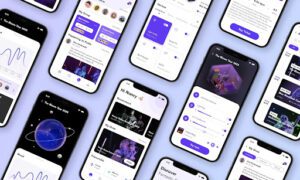Dating simulators, often referred to as dating sims, have captivated audiences worldwide for decades. Combining storytelling with interactive gameplay, these games simulate romantic relationships, offering players a unique blend of entertainment and emotional engagement. What began as simple text-based adventures has evolved into complex, AI-driven experiences. Today, tools like AI Girlfriend maker, which highlight the advanced capabilities of artificial intelligence, demonstrate the potential for creating highly personalized and immersive romantic simulations. This article explores the journey of dating simulators from their anime-inspired roots to the cutting-edge applications of AI technology.

The Origins of Dating Simulators
The concept of dating simulators emerged in the late 1980s and early 1990s, primarily in Japan. These games were heavily influenced by anime aesthetics and storytelling, featuring text-based narratives and simple graphics. Players would navigate romantic storylines by choosing dialogue options to influence the narrative’s direction. These early games often revolved around themes of high school romance, slice-of-life scenarios, and comedic misunderstandings, appealing to a niche but passionate audience.
Despite their simplicity, these games laid the foundation for a genre that would evolve dramatically, blending cultural storytelling with interactivity. They also introduced key mechanics, such as multiple endings based on player decisions, which remain central to the genre today.
Global Popularity and Advancements in Gameplay
In the late 1990s and early 2000s, dating simulators gained popularity beyond Japan. Technological advancements allowed for enhanced graphics, voice acting, and more intricate storylines. These improvements elevated the genre, making it more accessible and appealing to a global audience.
The integration of dating sim mechanics into other genres, such as role-playing games (RPGs), added emotional depth to gameplay. Players could build relationships with non-playable characters (NPCs), influencing both the narrative and their personal investment in the story. Customization also became a key feature, allowing players to tailor their characters and explore different romantic paths, further enhancing the replayability and depth of these games.
The Role of AI in Modern Dating Simulators
Artificial intelligence has revolutionized the gaming industry, and dating simulators are no exception. AI has introduced dynamic, adaptive gameplay, enabling virtual relationships that feel authentic and responsive.
AI-powered dating simulators now leverage natural language processing (NLP) and machine learning to generate real-time, personalized responses. Unlike traditional dating sims with fixed dialogue trees, AI-powered games offer limitless conversational possibilities, making interactions feel more genuine and immersive. Virtual characters can adapt to a player’s tone, choices, and preferences, creating an experience that evolves uniquely for each individual.
Emotional intelligence is another significant advancement. AI characters can detect and respond to players’ emotions through voice tone, word choice, or biometric data. This responsiveness fosters a sense of connection, elevating the gameplay experience.
Personalization and Cultural Relevance
One of the most transformative aspects of AI in dating simulators is the ability to create deeply personalized experiences. AI algorithms analyze user preferences and playstyles to tailor characters, storylines, and interactions to individual players. This customization fosters a sense of ownership and connection that traditional dating sims cannot achieve.
Additionally, AI has expanded the genre’s inclusivity. By generating characters that reflect diverse cultures, identities, and relationship dynamics, dating simulators have become more accessible and engaging for a wider audience.
The Future of Dating Simulators
The future of dating simulators is closely tied to the continued evolution of AI and its integration with emerging technologies.
Integration with Virtual and Augmented Reality
Virtual reality (VR) and augmented reality (AR) are poised to redefine the dating simulator experience. Players could immerse themselves in 3D environments, interacting with AI-driven characters in real-time. This level of immersion has the potential to create more emotionally impactful and memorable experiences.
Expanding Interpersonal Relationships
While romance remains central to the genre, future dating simulators may explore other types of relationships, such as friendships or mentorships. This expansion could broaden the genre’s appeal, offering players new ways to connect with virtual characters.
Ethical Considerations and Transparency
As AI becomes more sophisticated, the ethical implications of virtual relationships grow more complex. Developers must ensure that players understand the limitations and artificial nature of AI-driven characters to avoid unrealistic expectations or emotional dependency. Transparency and ethical guidelines will be critical to maintaining trust and promoting healthy interactions within these games.
Conclusion: A Genre in Transformation
From its humble beginnings as anime-inspired visual novels to the sophisticated AI-driven experiences of today, the evolution of dating simulators reflects broader trends in gaming and technology. AI has not only enhanced gameplay but also redefined how players engage with virtual relationships, offering unprecedented levels of personalization, realism, and emotional depth.
Tools like AI Girlfriend maker exemplify the potential for AI to create adaptive and immersive experiences. However, with this potential comes responsibility. Developers must navigate ethical challenges, ensure data privacy, and prioritize transparency to build trust with players.
As technology continues to advance, dating simulators will likely push the boundaries of interactivity and creativity. Whether exploring romance, friendship, or new types of relationships, the genre promises to captivate and connect players in ways that were once the realm of science fiction.


































